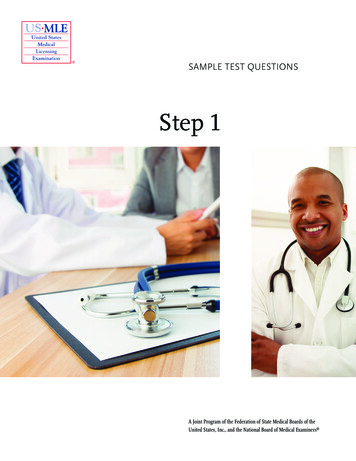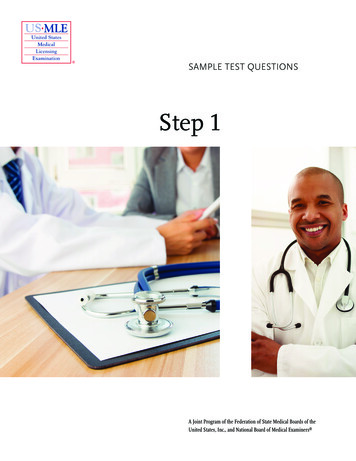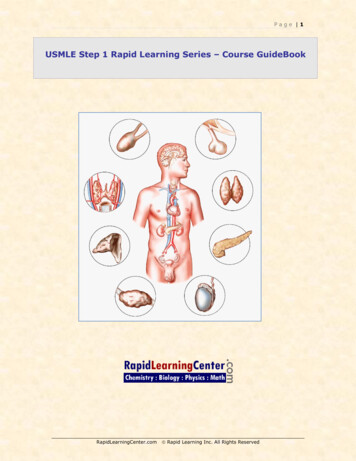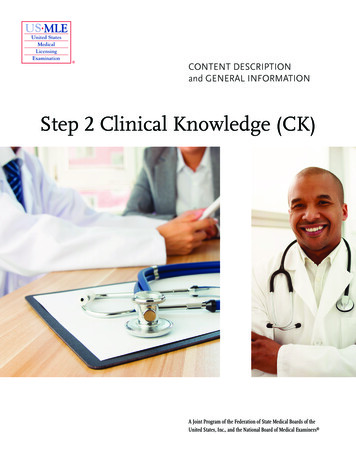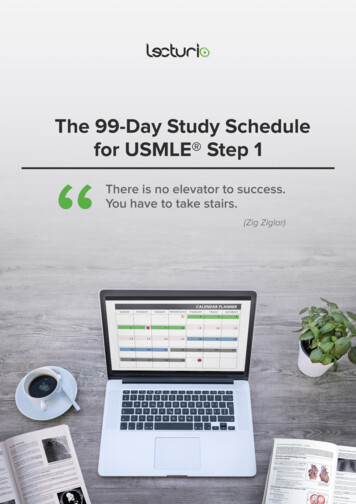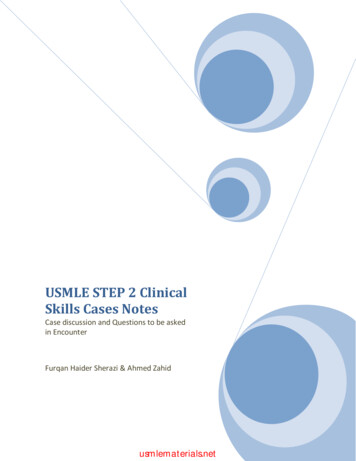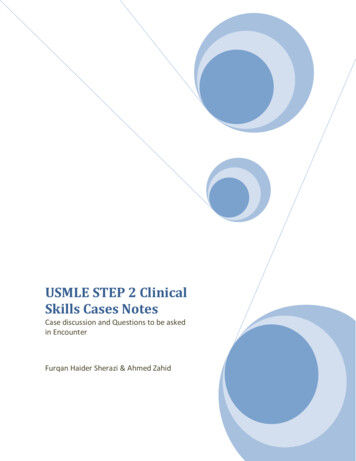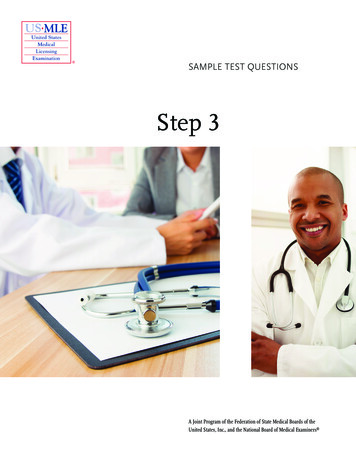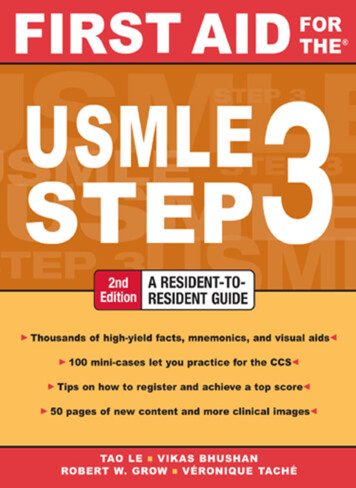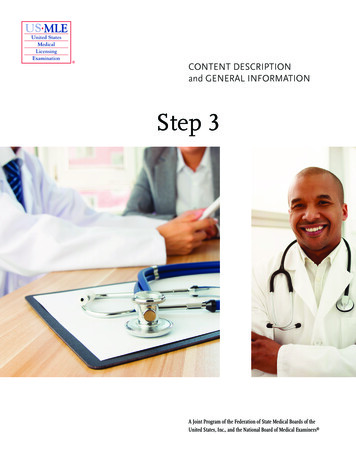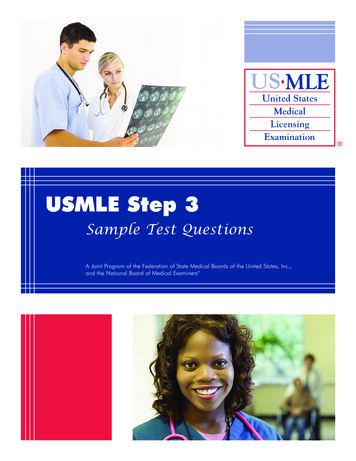
Transcription
USMLE Step 3Sample Test QuestionsA Joint Program of the Federation of State Medical Boards of the United States, Inc.,and the National Board of Medical Examiners
This booklet updated June 2014.Copyright 2014 by the Federation of State Medical Boards of the United States, Inc. (FSMB), and theNational Board of Medical Examiners (NBME ). All rights reserved. Printed in the United States ofAmerica. The United States Medical Licensing Examination (USMLE ) is a joint program of the FSMB andthe NBME.
CONTENTSUSMLE Step 3 Multiple Choice Test Question Formats . 2Introduction to USMLE Step 3 Sample Test Questions . 5USMLE Step 3 Normal Laboratory Values . 6Answer Form for USMLE Step 3 Sample Questions . 8USMLE Step 3 Sample Test Questions . 9Answer Key for USMLE Step 3 Sample Questions . 39
USMLE Step 3 Multiple Choice Test Question FormatsThe following are strategies for answering one-best-answer questions (eg, Single Items, Multiple Item Sets, andSequential Item Sets): Read each patient vignette and question carefully. It is important to understand what is being asked. Try to generate an answer and then look for it in the option list. Alternatively, read each option carefully, eliminating those that are clearly incorrect. Of the remaining options,select the one that is most correct. If unsure about an answer, it is better to guess since unanswered questions are automatically counted as wronganswers.Single Item QuestionsA single patient-centered vignette is associated with one question followed by four or more response options. Theresponse options for all questions are lettered (ie, A, B, C, D, E). You are required to select the best answer to thequestion. Other options may be partially correct, but there is only ONE BEST answer. This is the traditional, mostfrequently used multiple-choice question format on the examination.Example Question 11. A 30-year-old man comes to the emergency department because of an acute episode of renal colic. Medical historyis remarkable for episodes of painful urination and passing of what he calls "gravel in my urine." Urinalysisdemonstrates microscopic hematuria with some crystalluria and no casts. Supine x-ray of the abdomen shows noabnormalities. A 4-mm renal calculus is detected in the distal right ureter on ultrasonography. There is no evidenceof dilation of the collecting system. The patient's pain is responsive to narcotic medication. In addition toadministering intravenous fluids, which of the following is the most appropriate next step?A. Acidification of urine by drinking cranberry juiceB. Cystoscopic removal of the calculusC. Cystoscopic ureteral lavageD. Shock wave lithotripsyE. Straining of the urine(Answer: E)Multiple Item SetsA single patient-centered vignette may be associated with two or three consecutive questions about the informationpresented. Each question within these sets is associated with the patient vignette and is independent of the otherquestion(s) in the set. The items within this type of format are designed to be answered in any order. You are requiredto select the ONE BEST answer to each question.Example Questions 2 to 3A 52-year-old man returns to the office for reevaluation of an ulcer on his right great toe. The patient has a 15-yearhistory of diabetes mellitus and takes glipizide and rosiglitazone. He first noticed the ulcer 2 months ago. One monthago, a 14-day course of oral amoxicillin-clavulanate therapy was prescribed. He has smoked one pack of cigarettesdaily for the past 37 years. He is 178 cm (5 ft 10 in) tall and weighs 102 kg (225 lb); BMI is 32 kg/m2. Today, vitalsigns are temperature 38.8 C (101.8 F), pulse 96/min, respirations 12/min, and blood pressure 130/85 mm Hg.Physical examination of the right great toe discloses a 1.5-cm nontender ulcer with a depth of 0.5 cm, a moist base,yellow exudate, and surrounding erythema to the level of the malleoli. Vibration sense and sensation to monofilamentexamination are absent. Pulses are diminished in both feet. Capillary refill time is 2 seconds in the right great toe.Urinalysis discloses 3 protein.2
2. Which of the following historical factors or physical examination findings is most strongly associated withdevelopment of this patient's foot ulcer?A. Diminished pedal pulsesB. Neurologic findingsC. The patient's weightD. ProteinuriaE. Tobacco use(Answer: B)3. Which of the following is the most appropriate action at this time?A. Begin aggressive debridement in the officeB. Begin intravenous antibiotic therapyC. Refer the patient for transmetatarsal amputationD. Schedule the patient for a third-degree skin graftE. Switch the amoxicillin-clavulanate to oral ciprofloxacin(Answer: B)Sequential Item SetsA single patient-centered vignette may be associated with two or three consecutive questions about the informationpresented. Each question is associated with the initial patient vignette but is testing a different point. You are requiredto select the ONE BEST answer to each question. Questions are designed to be answered in sequential order. You mustclick "Proceed to Next Item" to view the next item in the set; once you click on this button, you will not be able to addor change an answer to the displayed (previous) item.Example Questions 4 to 5A 2-year-old girl is brought to the office by her mother for evaluation of fever. You have been the girl's physician sincebirth. While in the office, the girl stiffens and then has bilateral, symmetrical shaking of her upper and lowerextremities; she becomes mildly cyanotic. The episode lasts for approximately 45 seconds, after which she becomesrelaxed and appears to fall asleep. Vital signs at this time are temperature 40.0 C (104.0 F), pulse 120/min, andrespirations 40/min. On physical examination she has a generally pink complexion and flushed cheeks. She is limp andsomnolent and responds with a cry to noxious stimulus. Tympanic membranes are inflamed bilaterally, nose has ascant, clear discharge, and throat is mildly erythematous. Lungs are clear to auscultation except for transmitted upperairway sounds. Heart has rapid rate with a grade 1/6 systolic murmur at the left sternal border. Complete blood count,blood culture, lumbar puncture, and catheterized urine specimen are obtained and sent for stat analysis.Acetaminophen is administered by rectal suppository. Thirty minutes later the patient awakens and is smiling. She isafebrile. Additional history discloses that she was born at term, she had an uneventful neonatal course, she has normalgrowth and development, and vaccinations are up-to-date. She has never had an episode similar to this. Initiallaboratory results are shown:BloodWBCNeutrophils, segmentedNeutrophils, bandsLymphocytesMonocytesCerebrospinal fluidUrinalysisOther laboratory studies are pending.310,400/mm325%5%65%5%0 RBC/mm3Normal
4. In addition to ampicillin for otitis media and acetaminophen, this child also should receive which of the following?A. Oral ethosuximideB. Oral phenobarbitalC. Oral phenytoinD. Rectal diazepamE. No additional medications(Answer E)5. Two weeks later the patient is brought to the office for a follow-up visit. Her mother says that she is doing well andshe has had no recurrence of her symptoms. Examination of the ears shows resolution of the otitis media. Which ofthe following is the most important diagnostic step at this time?A. Audiology testingB. Cognitive testingC. CT scan of the headD. EEGE. No additional testing(Answer E)4
Introduction to USMLE Step 3 Sample Test QuestionsThe following pages include 77 sample test questions. Please note that reviewing the sample questions is not a substitutefor acquainting yourself with the test software. You should run the Step 3 tutorial and practice test items that areprovided on the USMLE website well before your test date. The sample materials on the USMLE website includeadditional items that do not appear in this booklet: pharmaceutical ads and abstracts, items with associated audio orvideo findings, and sequential item sets. You should become familiar with these formats as they will be used in theactual examination.In addition, the computer-based case simulation (CCS) format you will see on an actual Step 3 examination is notrepresented in this booklet. You must become familiar with the CCS format by reading information available in theUSMLE Content Description and General Information booklet and by practicing with sample CCS cases before youtake the Step 3 examination; the information and the practice materials are available on the USMLE website.These sample questions are illustrative of the types of questions used in the Step 3 examination. Although the questionsexemplify content on the examination, they may not reflect the content coverage on individual examinations. Questionsare grouped together by the content appropriate for each examination day in the same manner as in the actual computeradministered test blocks. In the actual examination, the questions will be presented one at a time in a format designedfor easy on-screen reading, including use of exhibit buttons (separate windows) for the table of normal LaboratoryValues (included here on pages 6–7) and some pictorials. Photographs, charts, and x-rays referred to in this booklet arenot of the same quality as the pictorials used in the actual examination. In addition, you will have the capability to adjustthe brightness and contrast of pictorials on the computer screen.To take the following sample test questions as they would be timed in the actual examination, you should allow amaximum of 1 hour for the 44-item block, and a maximum of 45 minutes for the 33-item block, for a total of 1 hour45 minutes. Please be aware that most examinees perceive the time pressure to be greater during an actual examination.An answer form for recording answers is provided on page 8. An answer key is provided on page 39. In the actualexamination, answers will be selected on the screen; no answer form will be provided.5
USMLE STEP 3 NORMAL LABORATORY VALUES* Included in the Biochemical ProfileBLOOD, PLASMA, SERUM* Alanine aminotransferase (ALT), serum .* Alkaline phosphatase, serum .Amylase, serum .* Aspartate aminotransferase (AST), serum .* Bilirubin, serum (adult), total // direct .Calcium, serum (total) .* Cholesterol, serumTotal.HDL.LDL.Cortisol, serum .Creatine kinase, serum .* Creatinine, serum .Electrolytes, serum* Sodium (Na ) .* Potassium (K ) .* Chloride (Cl–) .* Bicarbonate (HCO3–) .Magnesium (Mg2 ).Ferritin, serum .Follicle-stimulating hormone, serum/plasma .Gases, arterial blood (room air)PO2 .PCO2 .pH .* Glucose, serum .Immunoglobulins, serumIgA .IgE .IgG .IgM .Iron .Lactate dehydrogenase, serum .Luteinizing hormone, serum/plasma .Osmolality, serum .Phosphorus (inorganic), serum .Proteins, serumTotal (recumbent) .Albumin .Globulin .Thyroid-stimulating hormone (TSH), serum .Thyroxine (T4), serum .Triglycerides.Triiodothyronine (T3) resin uptake .* Urea nitrogen, serum .Uric acid, serum .REFERENCE RANGE10-40 U/L.Male: 30-100 U/L .Female: 45-115 U/L .25-125 U/L .15-40 U/L.0.1-1.0 mg/dL // 0.0-0.3 mg/dL .8.4-10.2 mg/dL .SI REFERENCE INTERVALS10-40 U/LMale: 30-100 U/LFemale: 45-115 U/L25-125 U/L15-40 U/L2-17 μ
Introduction to USMLE Step 3 Sample Test Questions The following pages include 77 sample test questions. Please note that reviewing the sample questions is not a substitute for acquainting yourself with the test software. You should run the Step 3 tutorial and practice test items that are provided on the USMLE website well before your test date. The sample materials on the USMLE website include


